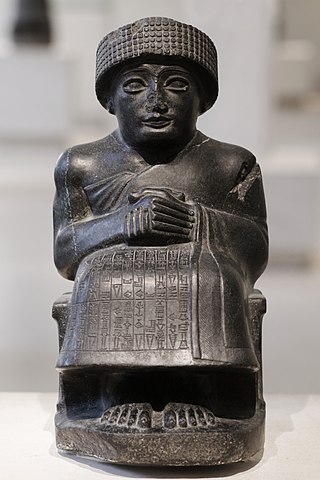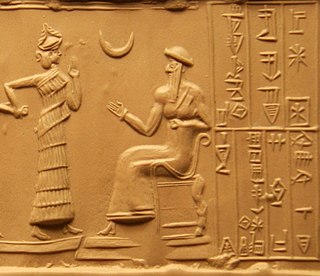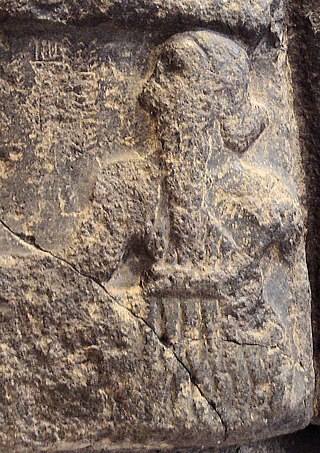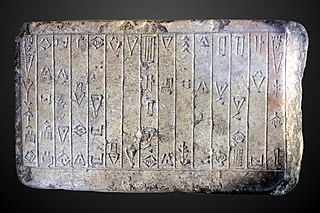| Ilulu | |
|---|---|
| King of the Akkadian Empire | |
| Reign | c. 2190-2189 BC |
| Predecessor | Nanum |
| Successor | Dudu |
Ilulu or Elulu, according to the Sumerian King List , was one of four rivals (the others being Igigi, Imi, and Nanum) vying to be king of the Akkadian Empire during a three-year period following the death of Shar-kali-sharri. [1] This chaotic period came to an end when Dudu consolidated his power over the realm.
While there is virtually no surviving evidence dating from this short timespan, thought to correspond with the first Gutian inroads into Akkadian territory, it has been suggested that this Ilulu is to be identified as the same as the Gutian king Elulmesh, also known from the kinglist. [2] [3]

The Akkadian Empire was the first ancient empire of Mesopotamia, succeeding the long-lived civilization of Sumer. Centered on the city of Akkad and its surrounding region, the empire would unite Akkadian and Sumerian speakers under one rule and exercised significant influence across Mesopotamia, the Levant, and Anatolia, sending military expeditions as far south as Dilmun and Magan in the Arabian Peninsula.

The Sumerian King List or Chronicle of the One Monarchy is an ancient literary composition written in Sumerian that was likely created and redacted to legitimize the claims to power of various city-states and kingdoms in southern Mesopotamia during the late third and early second millennium BC. It does so by repetitively listing Sumerian cities, the kings that ruled there, and the lengths of their reigns. Especially in the early part of the list, these reigns often span thousands of years. In the oldest known version, dated to the Ur III period but probably based on Akkadian source material, the SKL reflected a more linear transition of power from Kish, the first city to receive kingship, to Akkad. In later versions from the Old Babylonian period, the list consisted of a large number of cities between which kingship was transferred, reflecting a more cyclical view of how kingship came to a city, only to be inevitably replaced by the next. In its best-known and best-preserved version, as recorded on the Weld-Blundell Prism, the SKL begins with a number of antediluvian kings, who ruled before a flood swept over the land, after which kingship went to Kish. It ends with a dynasty from Isin, which is well-known from other contemporary sources.

The history of Sumer spans the 5th to 3rd millennia BCE in southern Mesopotamia, and is taken to include the prehistoric Ubaid and Uruk periods. Sumer was the region's earliest known civilization and ended with the downfall of the Third Dynasty of Ur around 2004 BCE. It was followed by a transitional period of Amorite states before the rise of Babylonia in the 18th century BCE.

Shar-Kali-Sharri reigned c. 2217–2193 BC as the ruler of the Akkadian Empire. In the early days of cuneiform scholarship the name was transcribed as "Shar-Gani-sharri". In the 1870s, Assyriologists thought Shar-Kali-Sharri was identical with the Sargon of Akkad, first ruler of the Akkadian Empire, but this identification was recognized as mistaken in the 1910s. His name was sometimes written with the leading Dingir sign demarking deification and sometimes without it. Clearly at some point he was deified and two of his designations marked his divine status, "heroic god of Akkade", and "god of the land of Warium". He was the son and successor of Naram-Sin who deified himself during his lifetime.
Nanum or Nanium, according to the Sumerian King List, was one of four rivals vying to be king of the Akkadian Empire during a three-year period following the death of Shar-kali-sharri. This chaotic period came to an end when Dudu consolidated his power over the realm.
Imi, according to the Sumerian King List, was one of four rivals vying to be king of the Akkadian Empire during a three-year period following the death of Shar-kali-sharri. This chaotic period came to an end when Dudu consolidated his power over the realm.

Shu-turul was the last king of the Akkadian Empire, ruling for 15 years according to the Sumerian king list. It indicates that he succeeded his father Dudu. A few artifacts, seal impressions etc. attest that he held sway over a greatly reduced Akkadian territory that included Kish, Tutub, Nippur, and Eshnunna. The Diyala river also bore the name "Shu-durul" at the time.

Ur-Nammu founded the Sumerian Third Dynasty of Ur, in southern Mesopotamia, following several centuries of Akkadian and Gutian rule. His main achievement was state-building, and Ur-Nammu is chiefly remembered today for his legal code, the Code of Ur-Nammu, the oldest known surviving example in the world. He held the titles of "King of Ur, and King of Sumer and Akkad".

The Gutian dynasty was a line of kings, originating among the Gutian people. Originally thought to be a horde that swept in and brought down Akkadian and Sumerian rule in Mesopotamia, the Gutians are now known to have been in the area for at least a century by then. By the end of the Akkadian period, the Sumerian city of Adab was occupied by the Gutians, who made it their capital. The Gutian Dynasty came to power in Mesopotamia near the end of the 3rd Millennium BC, after the decline and fall of the Akkadian Empire. How long Gutian kings held rulership over Mesopotamia is uncertain, with estimates ranging from a few years up to a century. The end of the Gutian dynasty is marked by the accession of Uruk ruler Utu-hengal, marking the short lived "Fifth dynasty of Uruk", followed by Ur ruler Ur-Nammu, founder of the Third Dynasty of Ur.

Dudu was a 22nd-century BC king of the Akkadian Empire, who reigned for 21 years c. 2189-2169 BC according to the Sumerian king list. Unlike his two predecessors Naram-Sin and Shar-Kali-Sharri he was not deified.

Lullubi,Lulubi, more commonly known as Lullu, were a group of Bronze Age tribes during the 3rd millennium BC, from a region known as Lulubum, now the Sharazor plain of the Zagros Mountains of modern-day Sulaymaniyah Governorate, Iraq. Lullubi was neighbour and sometimes ally with the Hurrian Simurrum kingdom. Frayne (1990) identified their city Lulubuna or Luluban with the region's modern town of Halabja.

The Guti, also known by the derived exonyms Gutians or Guteans, were a people of the ancient Near East. Their homeland was known as Gutium.

Sargon of Akkad, also known as Sargon the Great, was the first ruler of the Akkadian Empire, known for his conquests of the Sumerian city-states in the 24th to 23rd centuries BCE. He is sometimes identified as the first person in recorded history to rule over an empire.

Gutian is an extinct unclassified language that was spoken by the Gutian people, who briefly ruled over Sumer as the Gutian dynasty in the 22nd century BCE. The Gutians lived in the territory between the Zagros Mountains and the Tigris. Nothing is known about the language except its existence and a list of names of Gutian rulers in the Sumerian King List, which may reflect elements of the language.
Igigi, according to the Sumerian King List, was one of four rivals vying to be king of the Akkadian Empire during a three-year period following the death of Shar-kali-sharri. This chaotic period came to an end when Dudu consolidated his power over the realm.

Si'um, also Siium, or Sium was the 18th Gutian ruler of the Gutian Dynasty of Sumer mentioned on the "Sumerian King List" (SKL). According to the SKL: Si'um was the successor of Yarlaganda. Sium was the last king of the Gutians before Tirigan.
Elulmesh was the fourth Gutian ruler of the Gutian Dynasty of Sumer mentioned on the Sumerian King List. While there is virtually no surviving evidence dating from this short timespan, it has been suggested that this Elulmesh is to be identified as the same as the Akkadian king Ilulu, also known from the King List. Elulmesh was the successor of Shulme. Inimabakesh then succeeded Elulmesh.
Ur-nigin, also Ur-nigina or Ur-nigar was a Governor (ensi) of Uruk who lived in 22nd century BCE.
Ur-gigir was the son of Ur-nigin and a Governor (ensi) of Uruk who lived in 22nd century BCE.